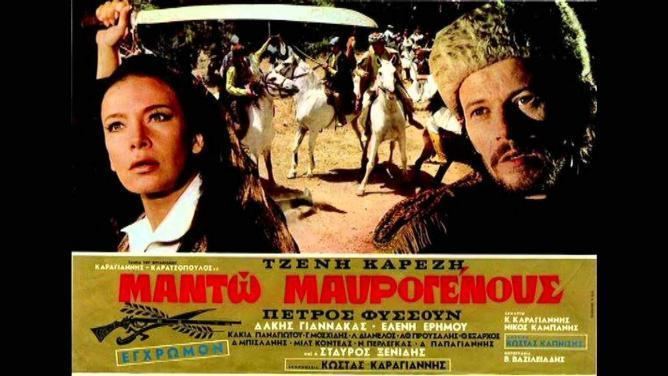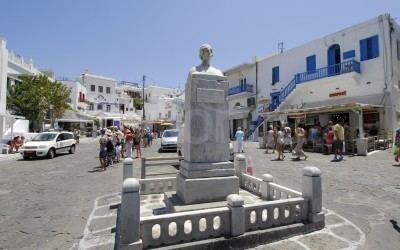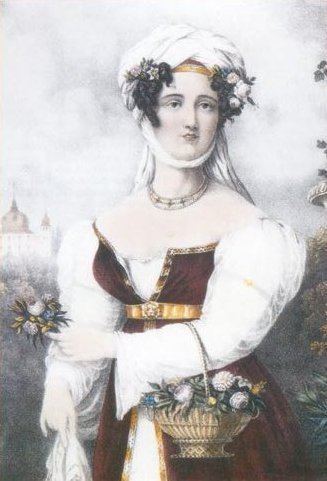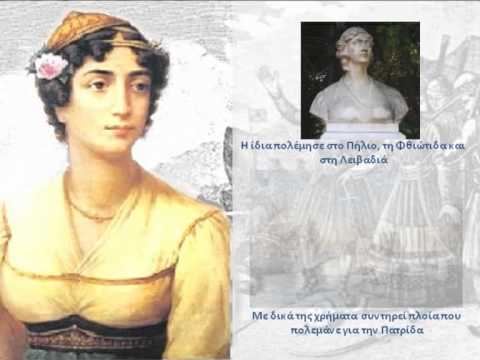Name Manto Mavrogenous | ||
 | ||
Rank Honorary Lieutenant General Relations Nikolaos Mavrogenes (father)Zacharati Chatzi Bati (mother) Parents Nikolaos Mavrogenes, Zacharati Chatzi Bati | ||
Manto Mavrogenous (Greek: Μαντώ Μαυρογένους) (1796 – July 1848) was a Greek heroine of the Greek War of Independence. A rich woman, she spent all her fortune for the Hellenic cause. Under her encouragement, her European friends contributed money and guns to the revolution.
Contents
Early life

Manto Mavrogenous was born in Trieste, then in the Habsburg Monarchy, now part of Italy. She was daughter of the merchant and member of the Filiki Eteria, Nikolaos Mavrogenes, and Zacharati Chatzi Bati. One of her ancestors, the great-uncle of her father, Nicholas Mavrogenes, was dragoman of the Ottoman Empire's fleet and Prince of Wallachia.

A beautiful woman of aristocratic lineage, she grew up in an educated family, influenced by the Age of Enlightenment. She studied ancient Greek philosophy and history at a college in Trieste, and spoke French, Italian and Turkish fluently.
War of Independence

In 1809, she moved to Paros with her family, where she learned from her father that the Filiki Eteria was preparing what would become known as the Greek Revolution and later, in 1818, after her father's death, she left for Tinos. When the struggle began, she went to Mykonos, the island of her origin, and invited the leaders of Mykonos to join the revolution.
She equipped, manned and "privateered" at her own expense, two ships with which she pursued the pirates who attacked Mykonos and other islands of Cyclades. On 22 October 1822, the Mykonians repulsed the Ottoman Turks, who had debarked on the island, under her leadership. She also equipped 150 men to campaign in the Peloponnese and sent forces and financial support to Samos, when the island was threatened by the Turks. Later, Mavrogenous sent another corps of fifty men to Peloponnese, who took part in the Siege of Tripolitsa and the fall of the town to the Greek rebels. Together, she spent money for the relief of the soldiers and their families, the preparation of a campaign to Northern Greece and the support of several philhellenes.
She later put together a fleet of six ships and an infantry consisting of sixteen companies, with fifty men each, and took part in the battle in Karystos in 1822, and funded a campaign to Chios, but she did not prevent it from the massacre. Another group of fifty men was sent to reinforce Nikitaras in the Battle of Dervenakia. When the Ottoman fleet appeared in Cyclades, she returned to Tinos and sold her jewelry to finance the equipment of 200 men who fought the enemy and cherish two thousand people who had survived from the first siege of Missolonghi. Her men participated in several other battles like those of Pelion, Phthiotis and Livadeia.
Mavrogenous led enlightenment expeditions in Europe and addressed an appeal to the women of Paris, to side up with the Greeks. She moved to Nafplio in 1823, in order to be in the core of the struggle, leaving her family as she was despised even by her mother because of her choices. It is the time that Mavrogenous met Demetrius Ypsilanti, with whom she was engaged. Soon, she became famous around Europe for her beauty and bravery. But in May of the same year, her home was totally burnt and her fortune was stolen, and as a result she went to Tripoli to live with Ypsilanti, while Papaflessas provided her with food.
When Ypsilanti broke up with Mavrogenous, she went back to Nafplio, where she almost lived, deeply depressed, as a hobo and was not paid the debts of the money she had given for various battles. After Ypsilanti's death and her political conflicts with Ioannis Kolettis, she was exiled from Nafplio and returned to Mykonos, where she occupied with the writing of her memoirs. While spending her fortune for the sake of the Greek war, she used to live in great poverty.
When the war ended Ioannis Kapodistrias awarded her the rank of the Lieutenant General and granted her a dwelling in Nafplio, where she moved. She owned a treasurable sword, with the inscription "Δίκασον Κύριε τους αδικούντας με, τους πολεμούντας με, βασίλευε των Βασιλευόντων", which is translated to 'Lord, judge those who wrong me, who battle me, rule over the Kings'. That sword is said to come from the times of Constantine the Great and Mavrogenous gave it to Kapodistrias.
Later years
Mavrogenous moved to Paros in 1840, where some of her relatives resided, and lived on the island where her home still stands as a historical monument, located close to the Panagia Ekatontapyliani (the Church of the Virgin Mary) which, tradition says, was founded by Saint Helena, mother of Constantine the Great. She died on Paros in July 1848, in oblivion and poverty, having spent all her fortune for the War of Independence.
Legacy
To pay homage to Mavrogenous, the people of Mykonos have named after her Chora's central square where her bust has been raised. The main square in the port town of Paroikia in Paros has also been given her name. Greece has honored this heroine by naming several streets after her. The Greek government has released several commemorative coins in her honor. A film was also made about her life, titled Manto Mavrogenous (1971), in which she was portrayed by Tzeni Karezi.
Mavrogenous was depicted on the reverse of the Greek 2 drachmas coin of 1988–2001.
